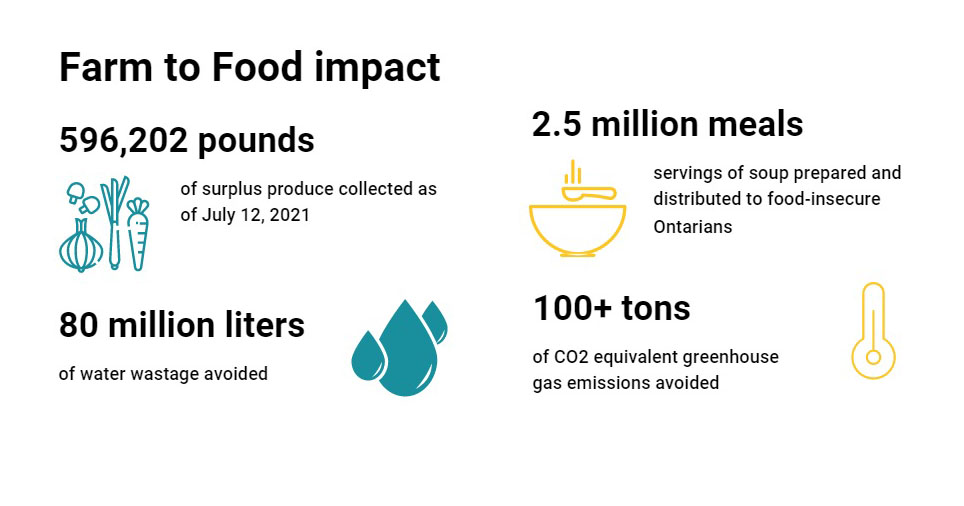Food waste is having a deeply felt impact on our physical environment.
At Food Banks Canada, we are all too familiar with the paradox of millions of tons of food decomposing while millions of people experience food insecurity in their daily lives. A report released in March 2020, for example, found that there were 4.4 million people—including more than 1.2 million children—living in food-insecure households in Canada in 2017–18.
According to the United Nations Environment Programme’s (UNEP’s) 2021 Food Waste Index Report, if food loss and waste were a country, it would be the third largest source of greenhouse gas emissions in the world.
When food is wasted, all of the water, fuel and other valuable inputs used in producing, processing, and transporting it are also squandered. Leftover food that ends up in landfills causes further fractures in our environment by generating methane, a greenhouse gas that is more than 25 times as dangerous as carbon dioxide when it comes to trapping heat in the atmosphere. In these ways and more, food waste exacerbates the climate change crisis with its significant GHG footprint.
To help accelerate the shift to more efficient and sustainable patterns of production and consumption, Food Banks Canada used funding from the Ontario Trillium Foundation in 2019 to partner with the UHC-Hub of Opportunities (UHC) in Windsor and Feed Ontario. Food Banks Canada’s role in the partnership was to evaluate the benefits of the UHC’s innovative Farm to Food program, which rescues surplus produce from farms in the rich agricultural region of Essex County in order to prepare and distribute nutritious soup to food-insecure Ontarians who need it the most.
READ MORE: How food banks rescued more than 200,000 pounds of produce to feed their communities
For Canadian Environment Week 2022, we’re sharing the results of the full, two-year evaluation of the Farm to Food program in hopes of inspiring other food banks, farmers and distributors to engage in food recovery and redirection initiatives in support of healthier communities and a healthier planet.
According to the final evaluation results prepared by Cathexis Consulting, the impact of food recovery operations such as Farm to Food, when quantified, can be staggering.
The Farm to Food program not only prepared and distributed 2.5 million meals to food-insecure Ontarians, but also avoided over 100 tons of CO2 equivalent greenhouse gas emissions.
The final evaluation found that the resourceful program had collected 596,202 pounds of surplus produce as of July 12, 2021. If dumped in the landfill, the decomposition of this produce would have produced methane emissions equivalent to 101,354 kg of carbon dioxide. This is equivalent to the emissions from about 316 cross-Canada one-way flights (Halifax to Vancouver), or driving a car with standard mileage about 403,748 km (equivalent to driving a car more than 10 times around the circumference of the Earth).
Through a combination of collaboration and operational excellence, Farm to Food also avoided 80 million liters of water wastage.
Of the 596,202 pounds of surplus produce collected, the evaluation found that about 80 per cent was carrots, potatoes, peppers and tomatoes. The amount of water typically needed to grow these crops averages 134.4 liters per pound.
Using this average, Cathexis Consulting estimated that the program avoided 80.1 million liters of water wastage, which is equivalent to the amount of water used annually by about 997 “average” Canadians. This amount of water could supply the town of Ear Falls, Ont. (population 995) with residential water for a year.

The Farm to Food program has even given farmers and distributors the feeling of making a positive contribution. They feel good because donating their produce helps people in their community, and their hard work doesn’t go to waste. As one food donor explained in the final evaluation report, “I really enjoy the idea of it being win-win-win; it’s not just for us and the community, but also the environment.”
ABOUT FARM TO FOOD
Since its inception in 2012, the Farm to Food program has worked with local growers to donate quality surplus food to hunger-relief agencies in more than 40 municipalities across Ontario, including Indigenous communities in northern parts of the province.
Using state-of-the-art kitchen facilities at the UHC, products rescued from local farms are transformed into cost-effective and nutritious servings of soup. Then, thanks to Feed Ontario’s extensive distribution network, the meals are transported to our neighbours in need.
Did You Know?
Much of the produce rescued by the UHC from local growers is stored at the Leamington Regional Food Hub (LRFH). Created in 2019, the LRFH serves as a secondary warehouse storage space encompassing 16,000 square feet. It also has two sorting lines and an industrial blast chiller/freezer so vegetables can be sorted and placed into pre-portioned packages for distribution.
Take Action
Through food recovery operations such as the UHC’s Farm to Food program, food banks are at the forefront of extending local supply chains to food-insecure individuals and reducing the environmental impact of food waste. Join us in supporting the national network of food banks working to address food insecurity for vulnerable populations across the country.